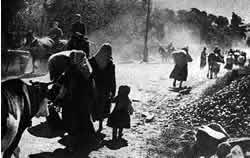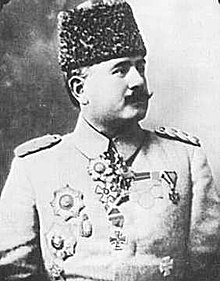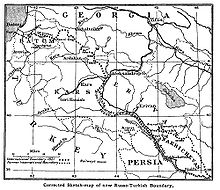Turkish-Armenian War
| date | September 24, 1920 to December 2, 1920 |
|---|---|
| place | South Caucasus and Democratic Republic of Armenia |
| Casus Belli | Skirmishes between Turkish and Armenian soldiers near Oltu |
| output | Turkish victory |
| consequences | Armenia gives more than half of its territory to Turkey. |
| Peace treaty | Treaty of Alexandropol |
| Parties to the conflict | |
|---|---|
| Commander | |
| Troop strength | |
| 20,000 fighters | Not more than 20,000 fighters |
| losses | |
|
198,000 (with civilians) |
|
The Turkish-Armenian War was a conflict between the Democratic Republic of Armenia and Turkish revolutionaries of the Turkish Independence Movement that lasted from September 24 to December 2, 1920 and largely took place in what is now northeastern Turkey and northwestern Armenia.
background
The Armenian National Liberation Movement declared the independence of the Democratic Republic of Armenia before the end of the First World War . Tovmas Nazarbekian, who was the commander in chief on the Caucasus Front and was also the administrator of the administration of Western Armenia , became the first leader of the Democratic Republic of Armenia. Andranik Toros Ozanian took over the administration of Western Armenia in the period from March to April 1918. He fought against the Ottoman army during the last fighting of the Caucasus campaign and appointed Drastamat Kanajan as civilian commissar.
Caucasus campaign in 1918
The Ottoman-Russian friendship treaty of January 1, 1918 and the subsequent Brest-Litovsk peace treaty of March 3, 1918, signed by Grand Vizier Talât Pasha , stipulated that all Russian conquests such as Ardahan , Kars and Batumi from the war of 1877 fell back to the Ottoman Empire until 1878 .
The new Armenian state, ruled by the Dashnaks , lay between Russia and the Ottoman Empire. The state received support from the Armenian diaspora from the west and was preparing to defend the Ottoman vilayets of Erzurum , Bitlis and Van . These were important to the Democratic Republic of Armenia in order to have access to the sea. In March 1918, Vehib Pasha marched with the Ottoman 3rd Army towards the Democratic Republic of Armenia and met Armenian volunteers who formed the core of the first Armenian army. Under the great pressure of the combined forces of the Ottoman army and the Kurdish irregular units, the fighters of the Democratic Republic of Armenia withdrew from Erzincan to Erzurum . The city of Van , which has been under Armenian control since the Van uprising , was also evacuated. The Armenians also evacuated the cities of Erzurum and Sarıkamış after the battles of Kara Killisse, Sardarapat and Abaran. Vehib Pasha also demanded Trabzon in the north.
Treaty of Batumi (June 4, 1918)
The border from the Brest-Litovsk peace treaty was enforced. Some additional conditions were imposed on the Democratic Republic of Armenia by the Treaty of Batumi . The signing of the treaty coincided with the proclamation of the Democratic Republic of Armenia.
In this treaty, the Ottoman Empire forced the Democratic Republic of Armenia to evacuate western Armenia, even though it was not recognized by Armenia. Meanwhile, the Mudros armistice of October 30, 1918, forced the Ottoman Empire to retreat beyond the pre-war borders of 1914.
Kars (December 1, 1918)
The time that had passed before the Mudros armistice was insufficient for the Ottomans to restore their authority over the territories lost with the Treaty of Batumi. The resulting power vacuum was filled by the Southwest Caucasian Republic under Fahrettin Pirioğlu with its center in Kars. It comprised the predominantly Muslim regions of Kars and Batumi, which were part of the Yerevan province, and the Akhaltsikhe and Akhalkalaki districts of the Tbilisi province. But in reality the government's authority was limited to Kars and Ardahan only. In addition, the area was under British army administration, which was formed during the intervention of the Allies in the Transcaucasus and the republic merely tolerated. Fahrettin Pirioğlu's government was then dissolved by the British High Commissioner Admiral Somerset Gough-Calthorpe . Then the Democratic Republic of Armenia was able to claim the area for itself. Ardahan was occupied by Georgian troops.
Active phase
Oltu Conflict (June 1920)
The conflict began in June 1920 when Armenian border troops were involved in skirmishes with Turkish irregulars from the Müdafaa-i Hukuk Cemiyeti ( Society for the Defense of Rights ) in the Oltu district , formerly under the control of the Democratic Republic of Georgia . On October 6, the government of the Democratic Republic of Armenia decided to occupy the district. Oltu was occupied by the Armenians on June 16. The Turkish government in Ankara saw this as a reason for war and sent General Kâzım Karabekir with four battalions to Oltu to drive out the Armenians. Karabekir then advanced into the Democratic Republic of Armenia on September 20, which led the Armenian government to declare war on Turkey four days later.
Sarıkamış, Kağızman, Merdenik (September 1920)
On September 21, Karabekir's troops captured Sarıkamış and, a day later, Kağızman . They then marched on Kars , but this attack was repulsed by the Armenian resistance. When the Turks took Merdenik (today Göle in Ardahan), the Armenians began pogroms against Muslims in Yerevan and Kars in response .
In early October, the government of the Democratic Republic of Armenia sought help from Great Britain , France , Italy and the rest of the allies , but few replies were received. Most of British forces in the Middle East were busy crushing a tribal rebellion in the British mandate of Mesopotamia , while France and Italy faced similar problems in the League of Nations Mandate Syria and Italian-controlled Antalya . Neighboring Georgia declared itself neutral. Only the Kingdom of Greece provided some assistance through its operations in Western Anatolia. But the Greek military support was insufficient to ease Turkish pressure on the Democratic Republic of Armenia.
Yerevan Agreement (October 1920)
On October 11th, the Soviet Plenipotentiary Boris Legran arrived in Yerevan with a text on an agreement between the Soviets and Armenia. The agreement signed on October 24 assured the Armenians of Soviet support. The most important part of the agreement dealt with Kars, which was supposed to protect Armenia. The Turkish independence movement was not happy about a possible settlement between the Soviets and Armenia. Karabekir was informed about Boris Legran by the Turkish parliament in Ankara and was supposed to solve the problem with Kars. When the agreement was signed, Karabekir marched towards Kars on the same day.
Kars and Alexandropol (October 1920)
On October 24th, Karabekir's troops launched a major attack on Kars. The Armenians left the city instead of defending it and so Kars came under Turkish control on October 30th. The residents, who were unable to escape, were subjected to looting, rape and massacres.
The Turkish troops continued their advance and took Alexandropol (now Gyumri) a week after Kars. On November 12, the Turks also took the strategically important village of Agin northeast of the ruins of the former Armenian capital Ani and moved from there to Yerevan. On November 13, Georgia broke its neutrality and invaded Lori , which had been established by the British in early 1919 as a neutral zone between Georgia and Armenia.
Treaty of Alexandropol (November 1920)
The Turks now had their headquarters in Alexandropol. On November 6th, the Armenians declared their intention to make peace. Turkey submitted its terms for peace on November 8th. An armistice was signed on November 18, 1920, and talks between the two governments began on November 26. On December 2nd, both sides signed the Treaty of Alexandropol . According to the treaty, the Armenian army was to be disarmed, more than 50% of pre-war Armenia was to be given to Turkey, and all territories assured to Armenia by the Treaty of Sèvres were to be given up.
During the negotiations, Joseph Stalin ordered Grigory Ordzhonikidze to invade the Democratic Republic of Armenia from Azerbaijan and set up a pro-Bolshevik government. On November 29th, the Soviet 11th Army invaded Karavansarai (now Ijevan ). The Treaty of Alexandropol could no longer be ratified by the Armenian Parliament because the Soviets took Armenia.
aftermath
End of the Democratic Republic of Armenia (December 1920)
On November 28, 1920, the 11th Red Army under Anatoly Gekker crossed the border to the Democratic Republic of Armenia from Soviet Azerbaijan. The reason given was an Armenian invasion of Şərur (November 20) and Nagorno-Karabakh (November 21). The argument lasted only a week. Tired from six years of constant war and conflict, the Armenian army and people could not offer any further resistance.
When the Red Army entered Yerevan on December 4, 1920, the Armenian government gave up. On December 5th, the Armenian Revolutionary Committee briefly Revkom, which consisted mostly of Armenians from Azerbaijan, arrived in the city. The following day, December 6th, the Cheka , Felix Dzerzhinski's secret police , entered Yerevan. The Democratic Republic of Armenia de facto ceased to exist.
On December 6, the Armenian Soviet Socialist Republic was proclaimed under the leadership of Aleksandr Miasnikyan. De jure , the Armenian SSR was not founded until December 22, 1922.
Treaty of Kars, October 23, 1921
The violence in Transcaucasia was ended by a friendship treaty between the Turkish Parliament (TBMM for short), which proclaimed the Republic of Turkey in 1923, and the Soviet Union. The Peace of Kars was signed in Kars by representatives of the Russian SFSR , the Azerbaijani SSR , the Armenian SSR , the Georgian SSR and the TBMM. On March 16, 1921, the TBMM had already signed a friendship and fraternity treaty , also known as the Moscow Treaty, with the Soviet Union . With this treaty Turkey ceded Ajaria to the USSR and received the province of Kars (today divided into the provinces of Kars , Ardahan and Iğdır ).
See also
Individual evidence
- ↑ a b c d e f g h i j k l m Andrew Andersen: Atlas of Conflicts: Turkish-Armenian War.
- ↑ a b c d e f g h i j k l m Robert H. Hewsen. Armenia: A Historical Atlas , p. 237. ISBN 0-226-33228-4
- ↑ a b c d e f g h i Turkish-Armenian War of 1920 (In Russian) ( Memento of the original from March 12, 2007 in the Internet Archive ) Info: The archive link was inserted automatically and has not yet been checked. Please check the original and archive link according to the instructions and then remove this notice.
- ↑ a b Anahide Ter Minassian: La république d'Arménie. 1918-1920 La mémoire du siècle. , éditions complexe, Bruxelles 1989 ISBN 2-87027-280-4 , p. 220
- ^ Vahakn N. Dadrian: The History of the Armenian Genocide: Ethnic Conflict from the Balkans to Anatolia to the Caucasus Berghahn Books, Providence, Oxford 2004, ISBN 978-1-57181-666-5 , p. 361
- ↑ Caucasian Knot ( Memento of the original from October 22, 2008 in the Internet Archive ) Info: The archive link was inserted automatically and has not yet been checked. Please check the original and archive link according to the instructions and then remove this notice. (Moscow-based news agency)
- ^ A b c The Republic of Armenia, Vol. IV: Between Crescent and Sickle: Partition and Sovietization Berkeley, Los Angeles, London: University of California Press, 1996, p. 259.


